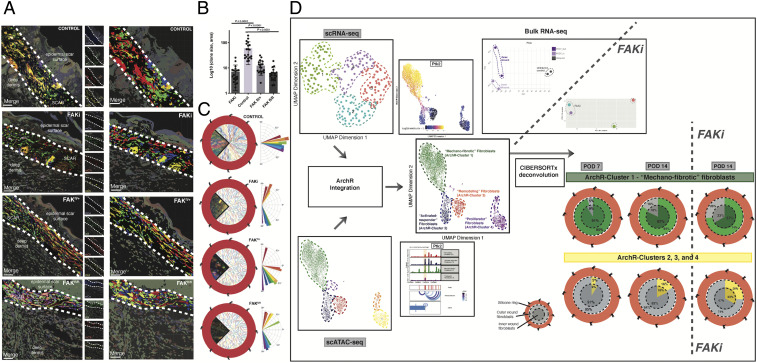Fig. 3.
Clonal proliferation of injury-responsive fibroblasts is dependent on mechanotransduction signaling. (A) Representative confocal images of sectioned Rainbow mouse wound specimens treated with FAKi (Second), FAKfl/+ (Third), or FAKfl/fl (Bottom) compared with vehicle control (Top). Imaris rendering in second column of images highlights individual Rainbow clones. Dermal wound area highlighted with thick white dotted line. n = 5. (Scale bars, 25 μm.) (B) Quantitation of average clone size based on Imaris rendering. (C) Wedge sections of representative whole-mount confocal images of Rainbow wound specimens embedded within surrounding wound schematics for vehicle control (Top), FAKi-treated (Second), FAKfl/+ (Third), and FAKfl/fl (Bottom) samples. Corresponding vector analyses are provided to the Right of each subpanel. (D) Schematic illustrating our approach to deconvolve bulk RNA-seq data using our multimodal scRNA–ATAC construct. Transcriptionally defined cluster labels from scRNA-seq analysis were projected onto the scATAC-seq manifold using an anchor transfer–based approach in ArchR as previously described (18) (Left column) to construct four multimodal fibroblast subpopulations. Putative names were assigned to these ArchR-clusters based on integrated functional and temporospatial characteristics. Feature and peak plots, above and below, for FAK (Ptk2) are provided for illustrative purposes (Center column). Deconvolution of bulk RNA-seq specimens representing wound fibroblasts treated with FAKi versus vehicle control (Right column) was then performed using CIBRERSORTx (19) (SI Appendix, Methods). Wound schematics (with silicone ring around the outside, and outer and inner regions indicated) are provided to represent CIBRERSORTx output identifying changes in the percentages of ArchR-cluster 1 (mechanofibrotic) cells in bulk samples over time and with/without FAKi treatment (shown in green). Parallel schematic of corresponding changes in other ArchR-clusters are provided in yellow.

